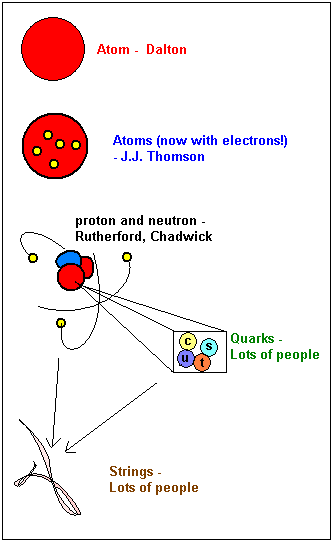A brief history of the smallest known objects:
A long time ago – Chinese philosophers suggest five basic elements: Wood, Fire, Earth, Metal, Water
Early 1800’s John Dalton comes up with his Atomic Theory. He suggests that all matter is made of indestructible, indivisible Atoms.
1897 – J.J. Thompson finds evidence of a smaller particle, the electron – develops the plum pudding model of an Atom
1919 – Ernest Rutherford does his alpha particle/gold foil experiment, finds evidence of a nucleus. Discovers the proton.
1932 – James Chadwick uncovers the neutron
1936 – The Muon (think heavier electron) is discovered by Carl Anderson
1960’s – Murray Gell-Mann and George Zweig begin work into the classification of the quark. Quarks are what make up protons and neutrons. There are six known quarkes named: Up, Down, Top, Bottom, Charm, and Strange.*
Late 1960’s early 1970’s – Scientists begin to suspect that quarks, and leptons (electron family) are made of single dimensional strings
1975 – The Tauon (think very heavy electron) is discovered by Martin Perl
1990 – String theory adapted to include the potential for multi-dimensions by Polchinski
1995 – Edward Witten develops the M-theory which suggests 11 dimensions for strings
A few weeks ago I was talking to Sander about a computer game (gimme friction). “I love this game because it appears to be perfectly analog, but really it’s limited by the number of pixels within the screen. That means that there are not an infinite number of games, it’s actually closer to finite than one originally observes.” Sander replied: “But aren’t most games defined by their resolution?” And he’s right.
As the simplest example, there’s tic tac toe – a game with only 9 binary pixels. Connect four has 42 binary pixels. Even more complicated games like risk have a set number of countries, a set number of pieces, a set number of cards, and a set number of dice potentials.
When I think about our quest for the smallest building block, I think we’re really looking for the pixel of the universe. I think we’re trying to define a resolution for our world. After which, things might suddenly become a lot less infinite.
*fun fact: according to wikipedia the top and bottom quark used to be referred to as the truth and beauty quark. Neat!
